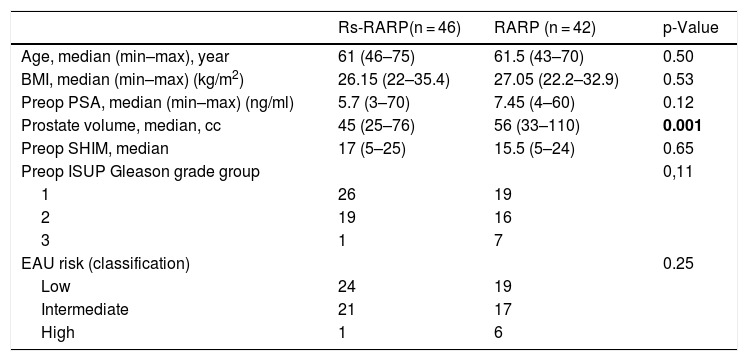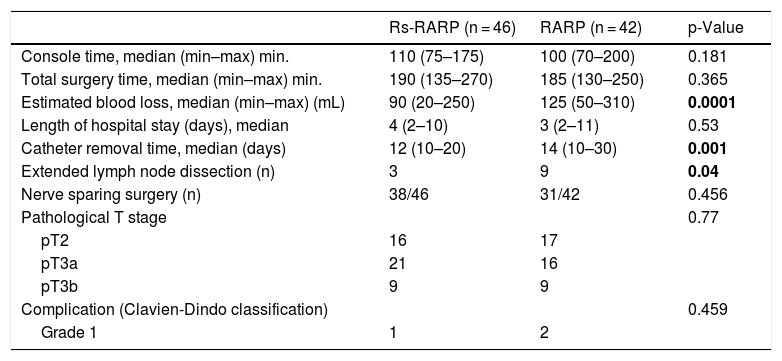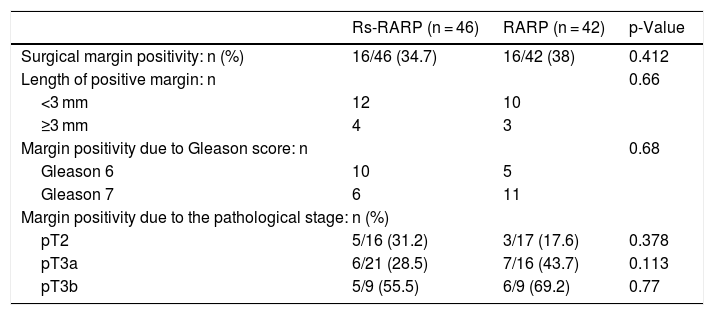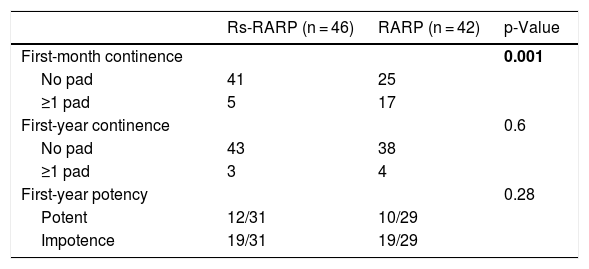We aim to compare the first year oncological and functional outcomes of Retzius-sparing robot-assisted radical prostatectomy (Rs-RARP) and standard robot-assisted radical prostatectomy (RARP).
Materials and methodsEighty-eight patients who underwent robotic radical prostatectomy between 2018–2019 were included. We compared the minimum one-year follow-up results of patients who underwent Rs-RARP or RARP in terms of oncological and functional outcomes. Potency was assessed with the Sexual Health Inventory for Men (SHIM) score and was defined as an erection sufficient for penetration. Continence was defined as the absence of urinary incontinence with no safety pad. Patients were evaluated in the first month of follow-up and subsequently, every three months.
ResultsForty-six patients in Rs-RARP and 42 patients in the RARP group were enrolled. Catheter removal time was shorter in the Rs-RARP group (12 vs. 14 days, p = 0.001). At the 1st month visit, 41 patients (%89) were continent (no pads) in the Rs-RARP group while 25 patients (%59) were continent in the RARP group (p = 0.001). Patients who underwent Rs-RARP achieved faster recovery of urinary continence (Log-rank, p = 0.001). After one year of follow-up, 43 patients (93%) in Rs-RARP group and 38 patients (90%) in RARP group were continent (p = 0.6). Potency rates were 38.7% in Rs-RARP and 34.4% in RARP group (p = 0.28). There were no cases of biochemical recurrence in any group.
ConclusionsRs-RARP is a feasible technique, providing early return of continence. However, overall continence rates were similar at the end of the one-year follow-up.
Nuestro objetivo fue comparar los resultados oncológicos y funcionales del primer año tras la prostatectomía radical asistida por robot con preservación del espacio de Retzius (PRAR-PR) y la prostatectomía radical estándar asistida por robot (PRAR).
Materiales y métodosSe incluyeron 88 pacientes sometidos a prostatectomía radical robótica entre 2018-2019. Se compararon los resultados oncológicos y funcionales de los pacientes que recibieron PRAR-PR o PRAR durante un periodo mínimo de seguimiento de un año. La potencia se evaluó con la puntuación del cuestionario de salud sexual del varón (Sexual Health Inventory for Men) y se definió como una erección con rigidez suficiente para la penetración. La continencia se definió como la ausencia de incontinencia urinaria sin compresa de seguridad. Los pacientes fueron evaluados en el primer mes y trimestralmente durante el resto del seguimiento.
ResultadosSe incluyeron 46 pacientes en el grupo PRAR-PR y 42 en el grupo PRAR. El tiempo de retirada del catéter fue menor en el grupo PRAR-PR (12 vs. 14 días, p = 0,001). En la consulta del primer mes 41 pacientes (89%) eran continentes (no utilizaban compresas) en el grupo PRAR-PR, mientras que 25 pacientes (59%) eran continentes en el grupo PRAR (p = 0,001). Los pacientes sometidos a PRAR-PR lograron una recuperación más rápida de la continencia urinaria (Log-rank, p = 0,001). Tras un año de seguimiento 43 pacientes (93%) del grupo PRAR-PR y 38 (90%) del grupo PRAR eran continentes (p = 0,6). Las tasas de potencia fueron del 38,7% en el grupo PRAR-PR y del 34,4% en el grupo PRAR (p = 0,28). No se observaron recurrencias bioquímicas en ningún grupo.
ConclusionesLa PRAR-PR es una técnica factible, que proporciona un retorno temprano de la continencia. Sin embargo, las tasas globales de continencia fueron similares al final del periodo de un año de seguimiento.












